1963 Datsun 320 kingcab
- wayno
- Posts: 5320
- Joined: Thu Jun 27, 2013 8:44 pm
- Location: Vancouver WA
- Has thanked: 432 times
- Been thanked: 1302 times
Re: 1963 Datsun 320 kingcab
So ever since I put the Weber on it, it has been idling like it had a lumpy cam, and it was polluting the garage even with the garage door wide open, I was looking into changing the jets as this Weber was on a MG Midget 1500 engine, and this is the stock E1(1200cc) engine, when I realized I was going to have to remove the top of the Weber I got depressed, while I was looking at it I seen a screw on the bottom back side of the carb, I thought maybe adjusting that screw might help a little, maybe, so I started turning it in and it got better and better, I turned it in till it died, then backed it off half a turn, started the engine and then adjusted it for the smoothest idle, it may be still jetted wrong, but it is idling good, when I get it on the road we shall see, I even had to lower the idle.
So what is too hot for the coil, it is warm, but I can still hold on to it when I grab it, are they supposed to get warm at all?
I never gave the coil much thought, I just get the correct one, install it and forget about it, so I don't know what normal operating temperature is.
So what is too hot for the coil, it is warm, but I can still hold on to it when I grab it, are they supposed to get warm at all?
I never gave the coil much thought, I just get the correct one, install it and forget about it, so I don't know what normal operating temperature is.
“The difference between genius and stupidly is that genius has its limits” Albert Einstein
- DRIVEN
- Posts: 7699
- Joined: Thu Jun 27, 2013 7:05 pm
- Location: I've been everywhere
- Has thanked: 1210 times
- Been thanked: 1180 times
Re: 1963 Datsun 320 kingcab
Warm to the touch isn't abnormal. I wouldn't worry about it but might carry a spare until it's been proven on some longish drives.
When the only tool you have is a hammer every problem starts to look like a hippy.
- wayno
- Posts: 5320
- Joined: Thu Jun 27, 2013 8:44 pm
- Location: Vancouver WA
- Has thanked: 432 times
- Been thanked: 1302 times
Re: 1963 Datsun 320 kingcab
I finished extending the skirts on the rest of the box, I used a buggered up 521 hood for sheet metal.
The passenger side front skirt
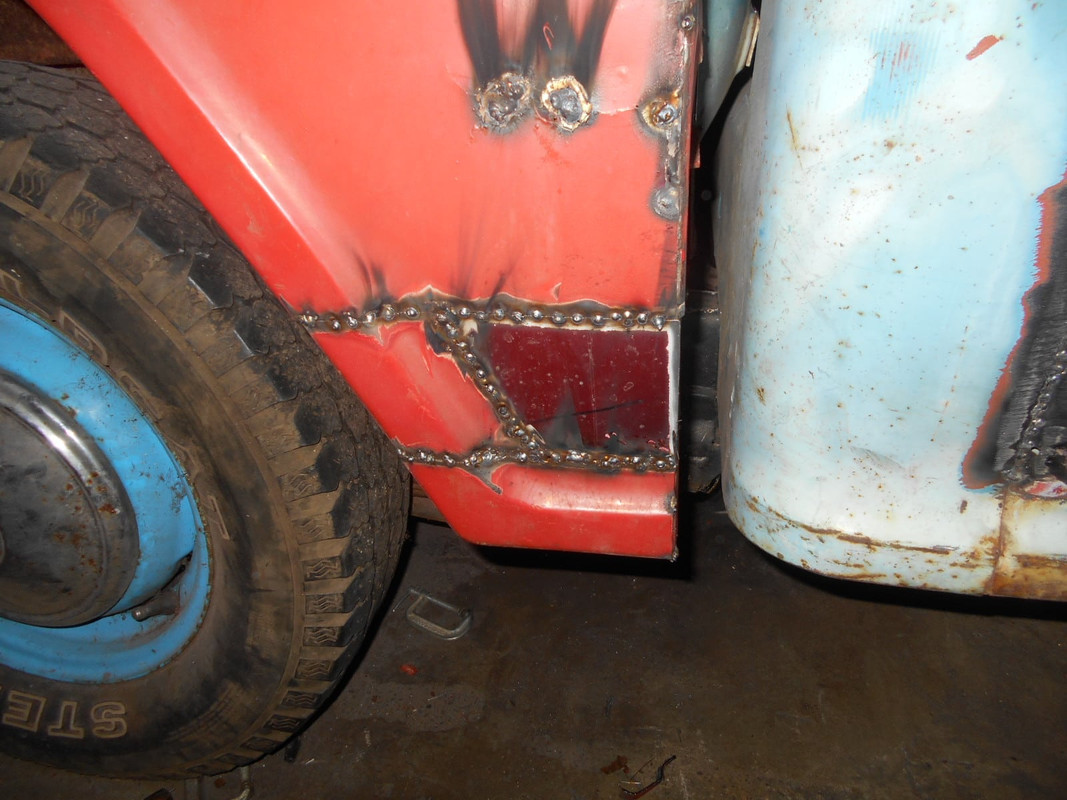
Passenger side rear skirt
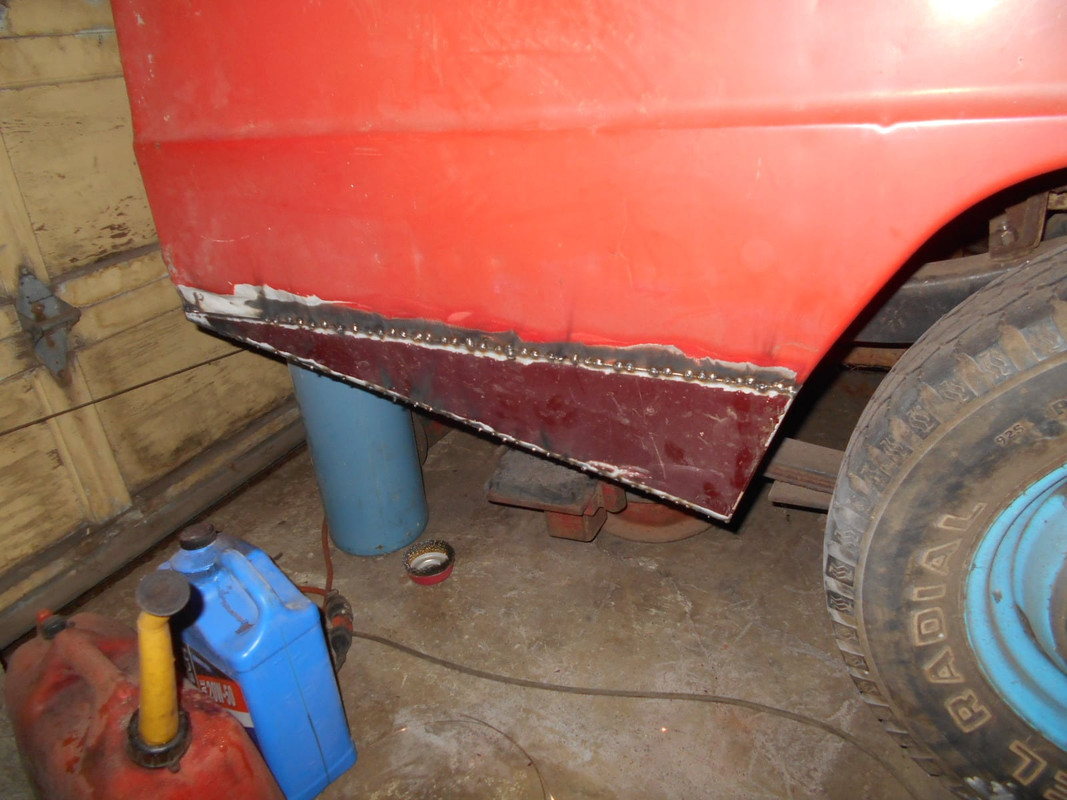
Driver side rear skirt
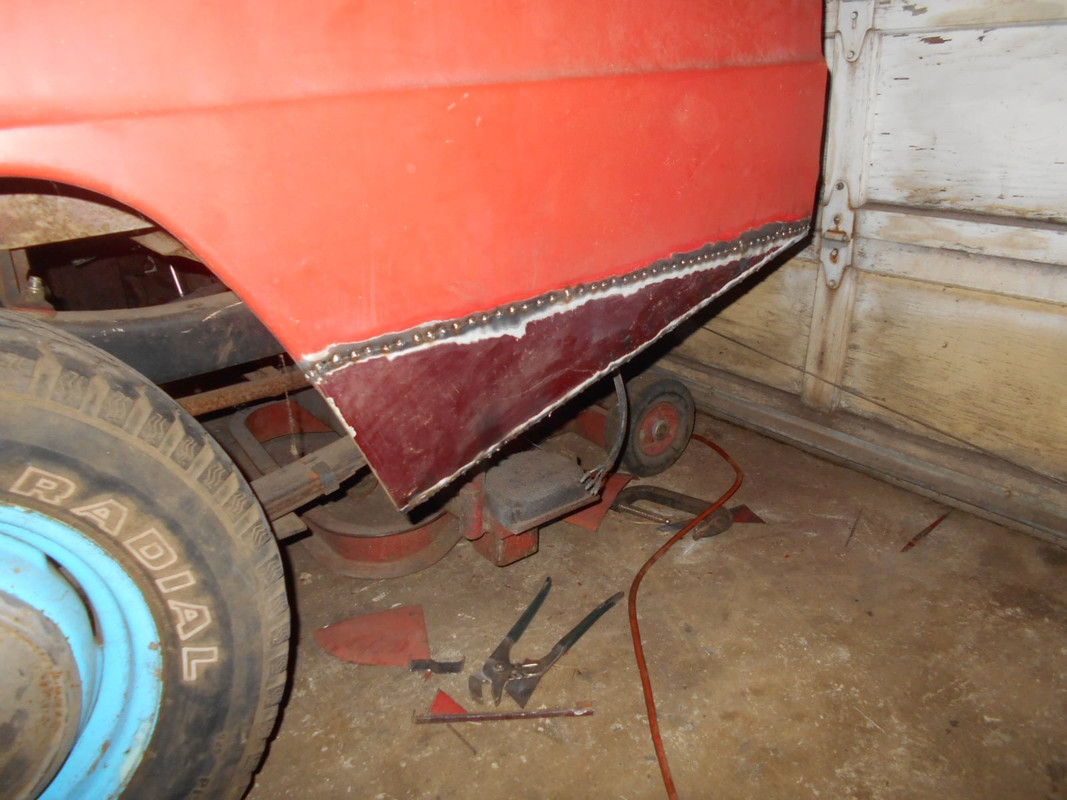
Everything looks close alignment wise on the sheet metal extensions, but will not know for sure until I get it out of the garage and look at it from a distance, then I will have to think about grinding stuff smooth and start covering all the welds up, that really makes a mess when I start sanding.
The passenger side front skirt

Passenger side rear skirt

Driver side rear skirt

Everything looks close alignment wise on the sheet metal extensions, but will not know for sure until I get it out of the garage and look at it from a distance, then I will have to think about grinding stuff smooth and start covering all the welds up, that really makes a mess when I start sanding.
“The difference between genius and stupidly is that genius has its limits” Albert Einstein
- wayno
- Posts: 5320
- Joined: Thu Jun 27, 2013 8:44 pm
- Location: Vancouver WA
- Has thanked: 432 times
- Been thanked: 1302 times
Re: 1963 Datsun 320 kingcab
I said I was saving the box front corners.

Well today I installed them.

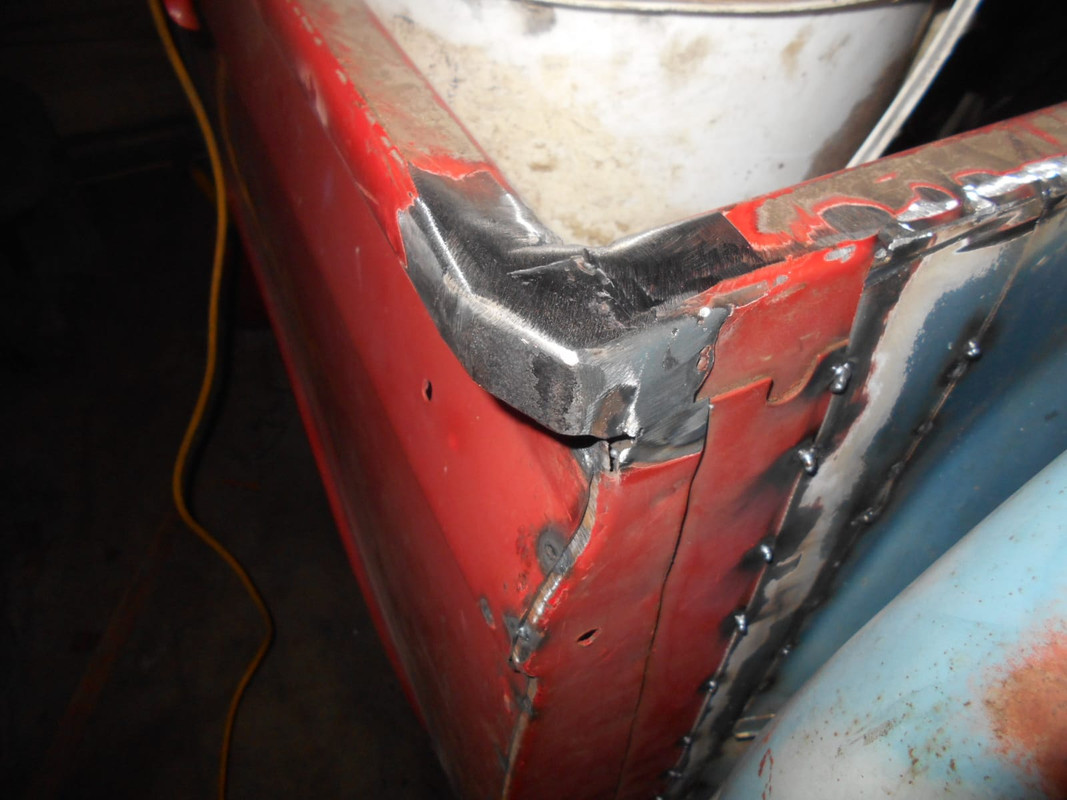
You can see how they were in this photo below, it was just an open end on the rail.
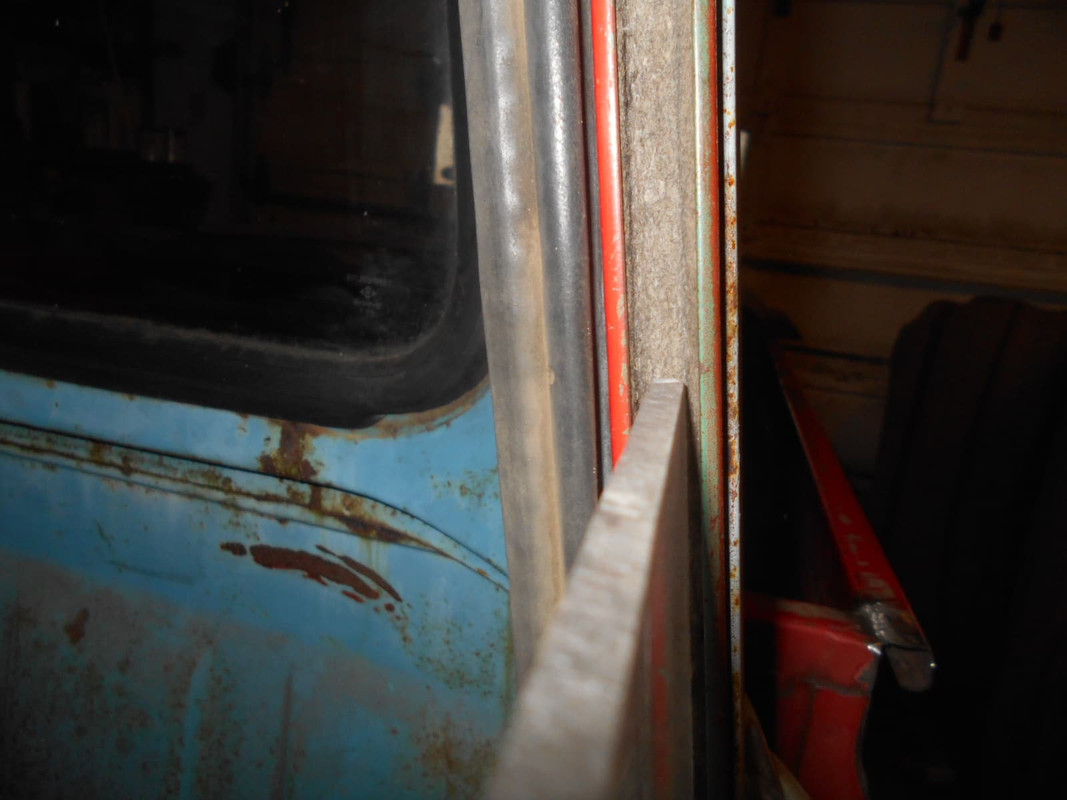
I didn't get much done on this today, I was out doing bids and fixing/un-clogging a valley at a regular customers house, have to keep everyone happy, it wasn't raining, and it was above 50 degrees.

Well today I installed them.


You can see how they were in this photo below, it was just an open end on the rail.

I didn't get much done on this today, I was out doing bids and fixing/un-clogging a valley at a regular customers house, have to keep everyone happy, it wasn't raining, and it was above 50 degrees.
“The difference between genius and stupidly is that genius has its limits” Albert Einstein
- wayno
- Posts: 5320
- Joined: Thu Jun 27, 2013 8:44 pm
- Location: Vancouver WA
- Has thanked: 432 times
- Been thanked: 1302 times
Re: 1963 Datsun 320 kingcab
The last few days I have been trying to do the front drop arms and disc brakes, unfortunately it has been so long since I did the U320 that I forgot most everything about doing them.
I went over to Mikes to show him what I had, I was very confused, well it turned out that I had all the parts I needed, but didn't even know I had them, the bearing adapters were wrapped in blue paper/cloth that I thought was just filler in the box that the disc brake brackets were in, Mike traded me the heat the adapter up in the oven and get it on the spindle for adapters that use locktite to hold them in place, I believe this made my job easier.
I bought the rotors/calipers for this a few years ago, well it turns out neither of the parts will fit the disc brake brackets Mike makes, I need 1984 Nissan rotors/calipers to complete this mod, but the parts I have will fit the work truck, so I didn't waste my money.
Several years ago I tried removing the lower control arm on this truck, I was wailing on a piece of re-bar centered on the bolt holding the lower control arm on, I tried again and had no more success, I was trying to figure out how to cut the bolt without damaging the control arm or the mount, I could not figure out how to do it, and I got this idea, the lower control arm has a star head on the bolt, there is this arm connected to the LCA that goes over the star bolt head, the torsion bar goes into the other half of that arm, if I reversed the arm so it stuck out, I could put a cheater bar on the end of it and pull really hard to try to turn that LCA bolt to loosen it up, it did give grudgingly, so I tried the re-bar and splitting maul again but it didn't move at all, this LCA bolt is a smooth shaft that goes thru the bushing, it has no threads, well even though it has no threads, every time I turned it a quarter of a turn it came out a 1/16th inch, the thing is 6 inches long, but after pulling on that arm, taking it off and re-positioning it over and over for half an hour or more, it finally came out, what a pain that was, but the funniest thing about it is after the arm was off, I could slide that bolt in and out of the hole with my fingers, but the end of the bolt was ruined from pounding on it with the splitting maul before and this time also,i I would have the nut half way on the bolt, and the other half had the re-bar end in it to try and keep the end of the bolt from flaring, but they both got ruined this time, the other side came out easy.
So tomorrow I will go to the parts store and order/buy 1984 Nissan 720 rotors/calipers, I seriously doubt that they will have them on the shelves, but I have to have them.
If they don't have them I will attempt to put drop blocks in the rear, not sure if I have the long U-bolts, may have to order them also.
Here is how far I am.
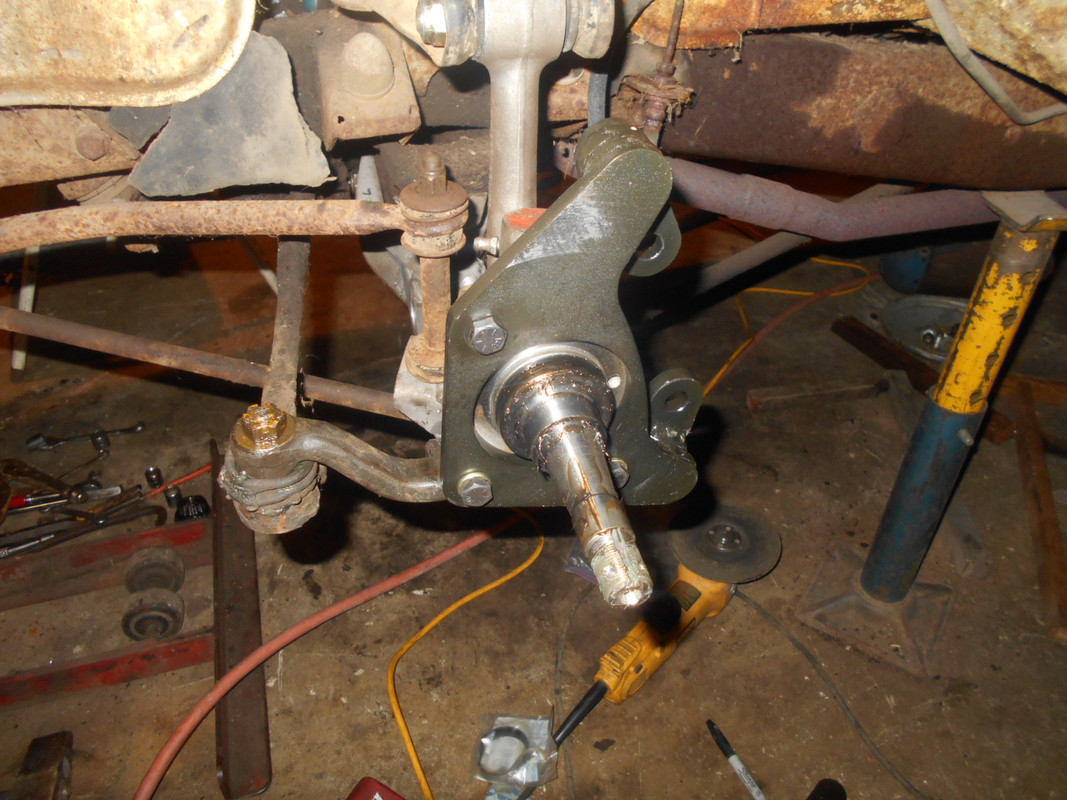
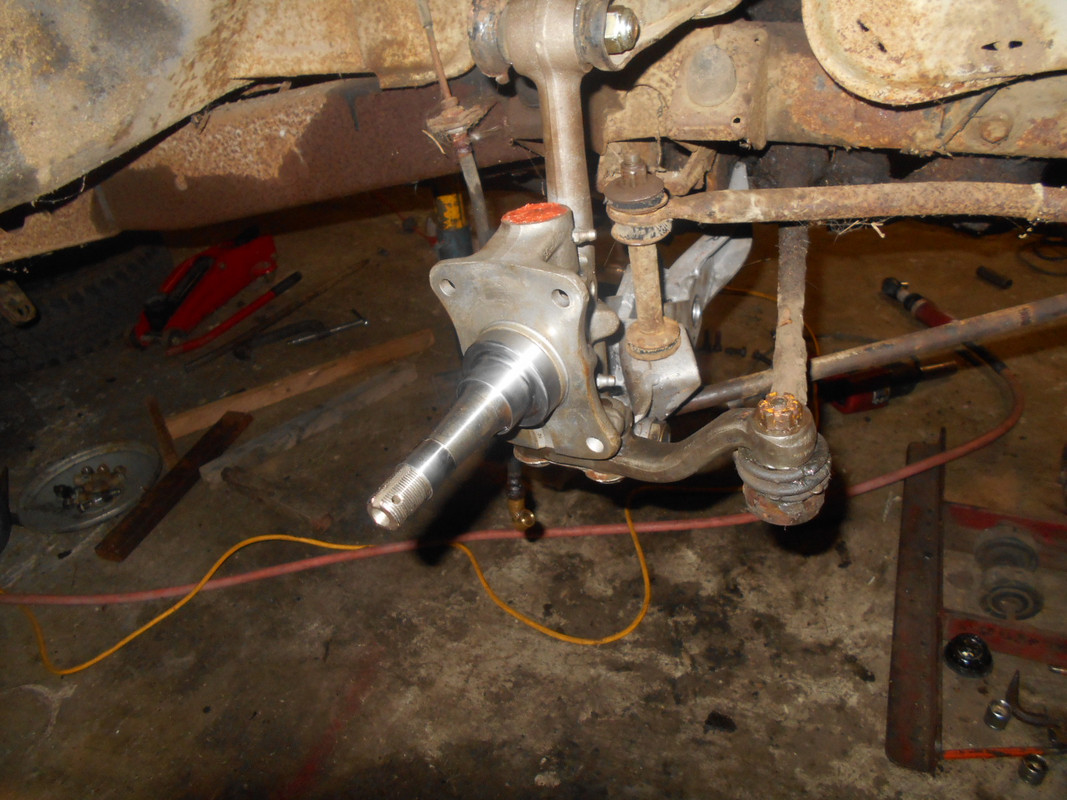
I had to make these seals for the spindle/control arm connection(fulcrum pin), there was a large gap that could not be filled with an O-ring.
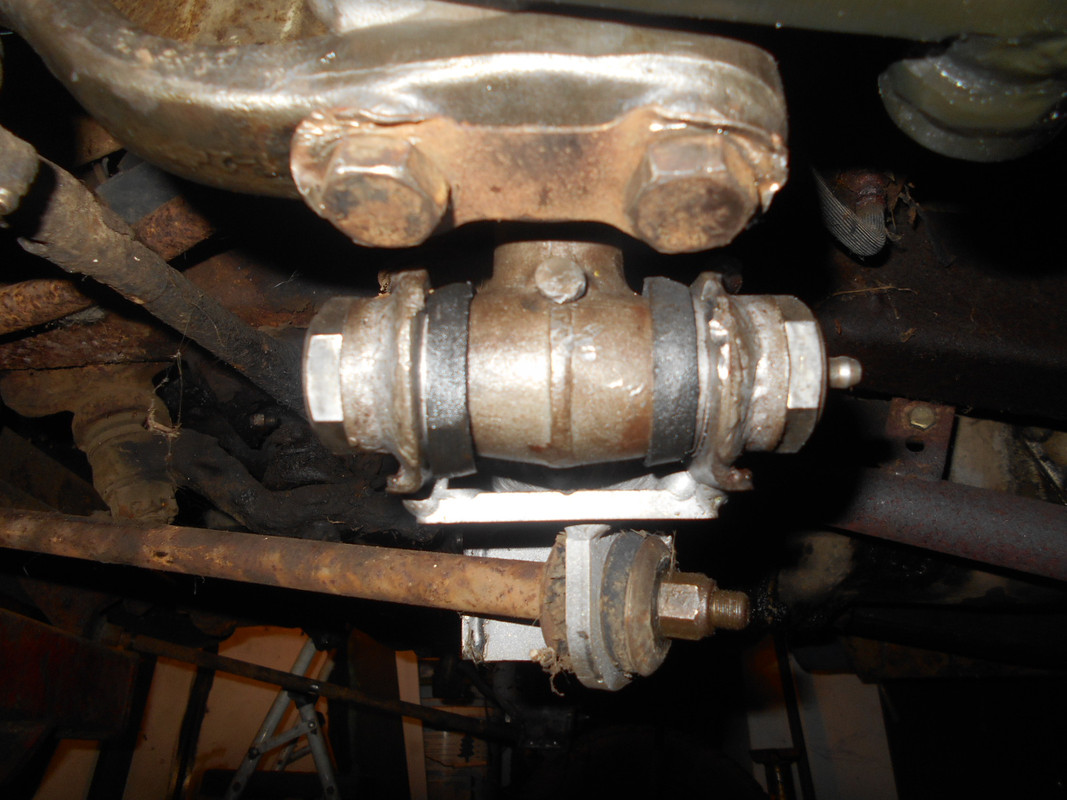
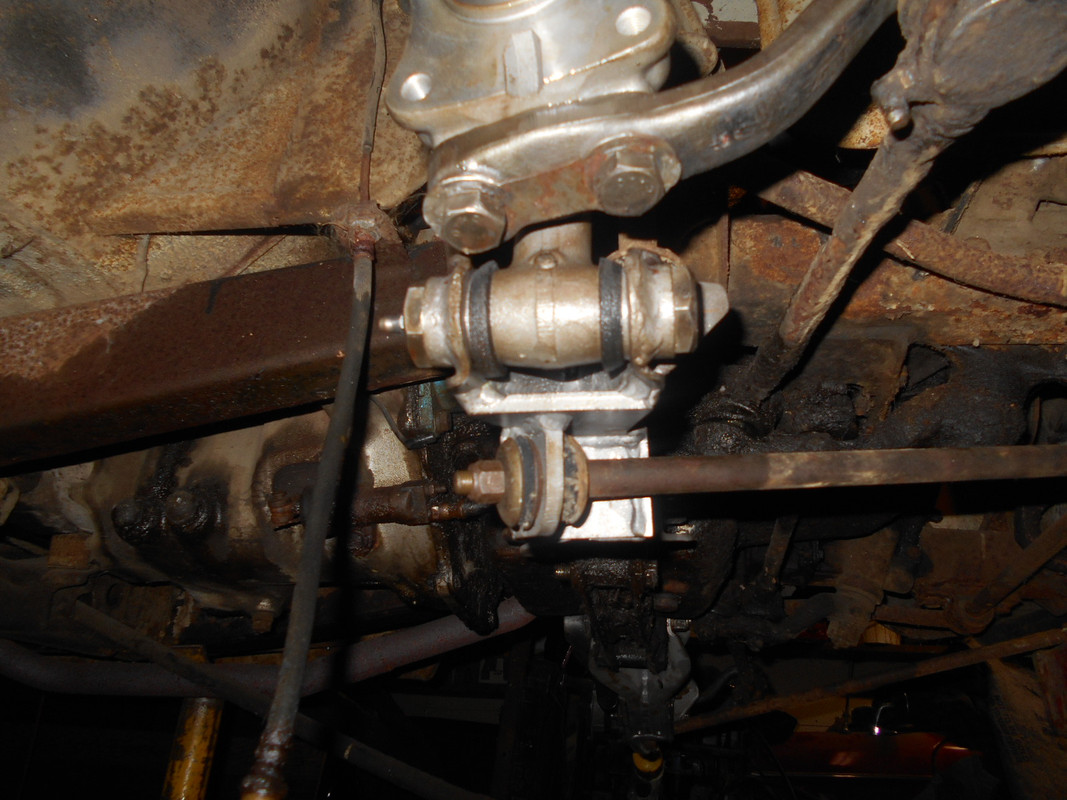
It was nice visiting with Mike, his CNC machine is something, the last time I was there it was just a machine in the middle of the garage, now it has a giant tray with curtains to keep the metal chips inside, it takes up a lot of room, he needs a larger garage, but he is very organized as he has no room not to be organized, every bit of room is used.
He has some cool new disc brake brackets made out of aluminum, I took home my drop spindles he was borrowing for clearance checks and whatever else he needed to use them for, now has has room for a good sized box in that spot.
I went over to Mikes to show him what I had, I was very confused, well it turned out that I had all the parts I needed, but didn't even know I had them, the bearing adapters were wrapped in blue paper/cloth that I thought was just filler in the box that the disc brake brackets were in, Mike traded me the heat the adapter up in the oven and get it on the spindle for adapters that use locktite to hold them in place, I believe this made my job easier.
I bought the rotors/calipers for this a few years ago, well it turns out neither of the parts will fit the disc brake brackets Mike makes, I need 1984 Nissan rotors/calipers to complete this mod, but the parts I have will fit the work truck, so I didn't waste my money.
Several years ago I tried removing the lower control arm on this truck, I was wailing on a piece of re-bar centered on the bolt holding the lower control arm on, I tried again and had no more success, I was trying to figure out how to cut the bolt without damaging the control arm or the mount, I could not figure out how to do it, and I got this idea, the lower control arm has a star head on the bolt, there is this arm connected to the LCA that goes over the star bolt head, the torsion bar goes into the other half of that arm, if I reversed the arm so it stuck out, I could put a cheater bar on the end of it and pull really hard to try to turn that LCA bolt to loosen it up, it did give grudgingly, so I tried the re-bar and splitting maul again but it didn't move at all, this LCA bolt is a smooth shaft that goes thru the bushing, it has no threads, well even though it has no threads, every time I turned it a quarter of a turn it came out a 1/16th inch, the thing is 6 inches long, but after pulling on that arm, taking it off and re-positioning it over and over for half an hour or more, it finally came out, what a pain that was, but the funniest thing about it is after the arm was off, I could slide that bolt in and out of the hole with my fingers, but the end of the bolt was ruined from pounding on it with the splitting maul before and this time also,i I would have the nut half way on the bolt, and the other half had the re-bar end in it to try and keep the end of the bolt from flaring, but they both got ruined this time, the other side came out easy.
So tomorrow I will go to the parts store and order/buy 1984 Nissan 720 rotors/calipers, I seriously doubt that they will have them on the shelves, but I have to have them.
If they don't have them I will attempt to put drop blocks in the rear, not sure if I have the long U-bolts, may have to order them also.
Here is how far I am.


I had to make these seals for the spindle/control arm connection(fulcrum pin), there was a large gap that could not be filled with an O-ring.


It was nice visiting with Mike, his CNC machine is something, the last time I was there it was just a machine in the middle of the garage, now it has a giant tray with curtains to keep the metal chips inside, it takes up a lot of room, he needs a larger garage, but he is very organized as he has no room not to be organized, every bit of room is used.
He has some cool new disc brake brackets made out of aluminum, I took home my drop spindles he was borrowing for clearance checks and whatever else he needed to use them for, now has has room for a good sized box in that spot.
“The difference between genius and stupidly is that genius has its limits” Albert Einstein
- wayno
- Posts: 5320
- Joined: Thu Jun 27, 2013 8:44 pm
- Location: Vancouver WA
- Has thanked: 432 times
- Been thanked: 1302 times
Re: 1963 Datsun 320 kingcab
The front brakes are done, I have not bled them yet.
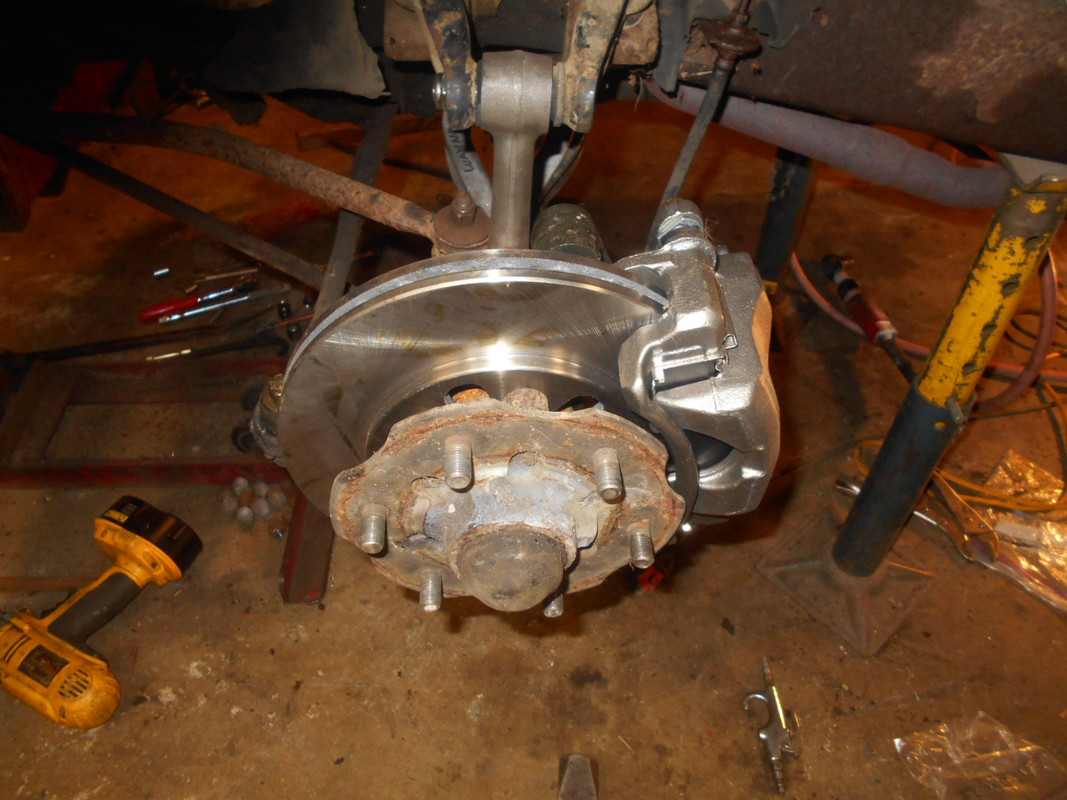
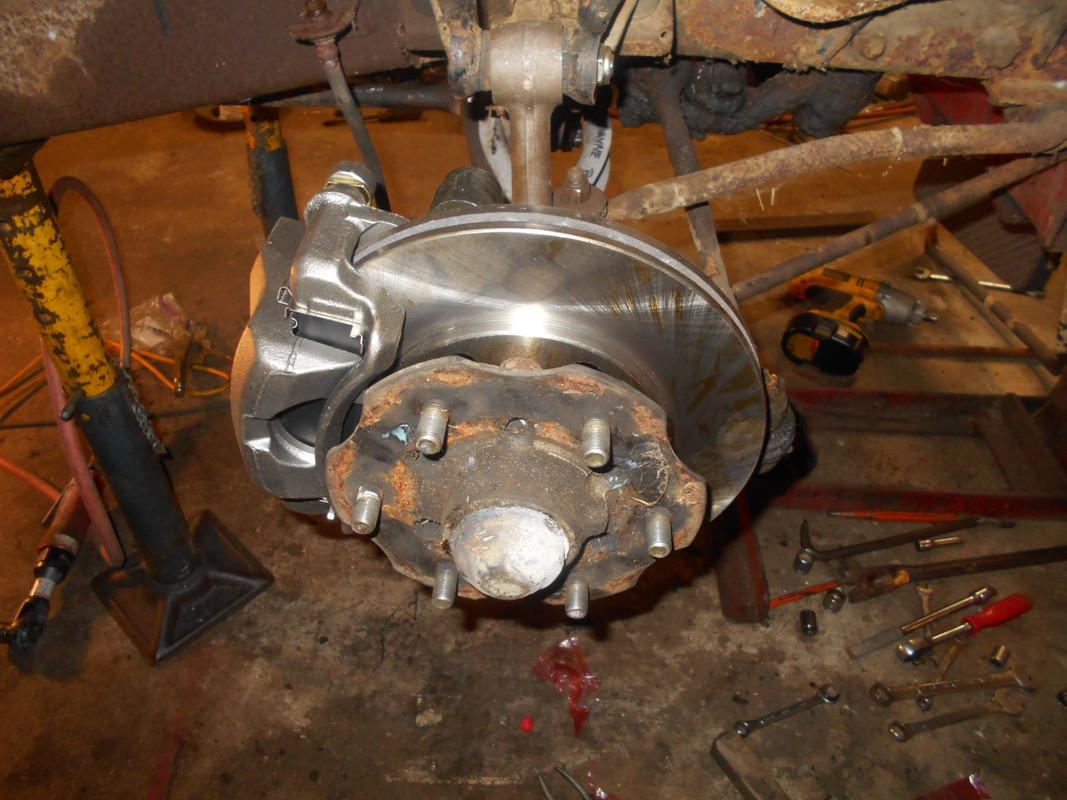
I have brake lines coming for these disc brake calipers, but I looked at the stock soft brake line ends, they looked like the banjo bolt was the same size, so I tried the new banjo bolt in the old brake line end and it fit fine till the last eighth inch, so I counter sunk the end of the line so it fit properly, and attached the old lines to the new calipers, I will find out when I bleed the brakes if it worked, this way I don't have to remove the brake lines from the truck to replace the SAE fitting with a metric fitting so it will connect to the new soft brake line.
The stock 320 rims will not clear the calipers, they are hitting the rivets dead center and the piece of metal left of the rivet, they all hit, I can pound down the metal pieces with no issues, but the rivets I can only grind on, they barely hit right now, not sure until after I bleed the brakes, they might get better, worse, or stay the same after bleeding the brakes, you can barely see where they have hit, it looks like two silver spots in the photo.
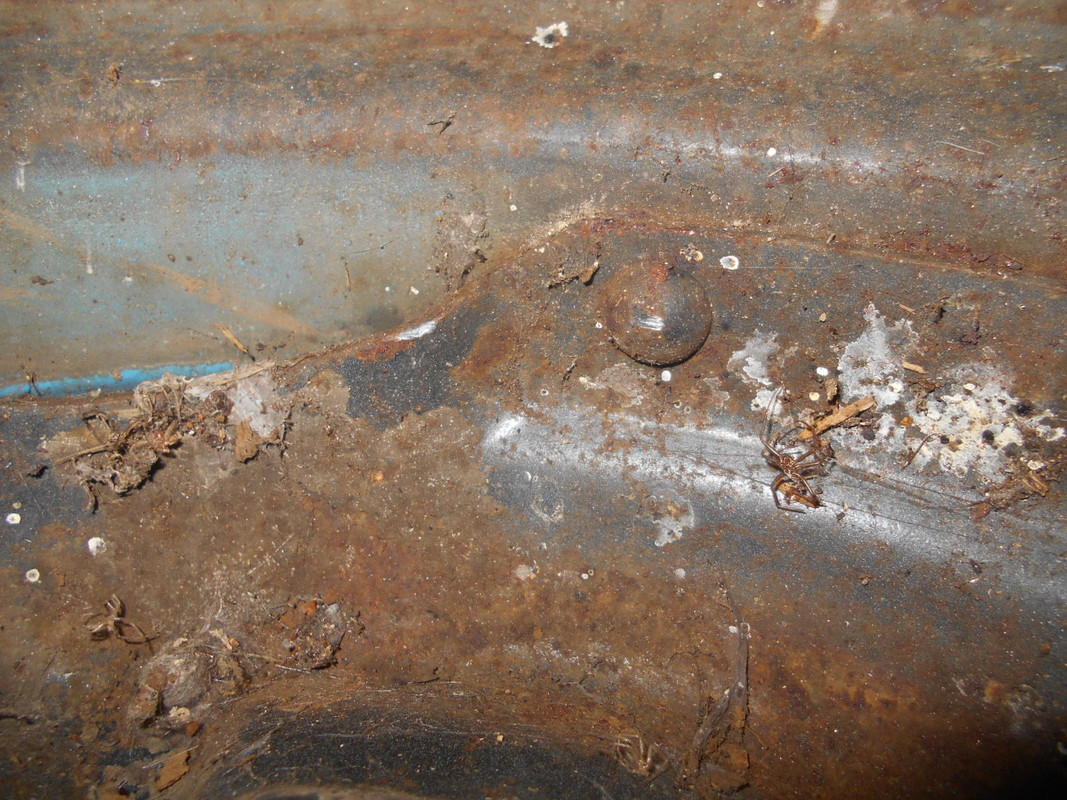
I put 3 inch drop blocks in the rear.
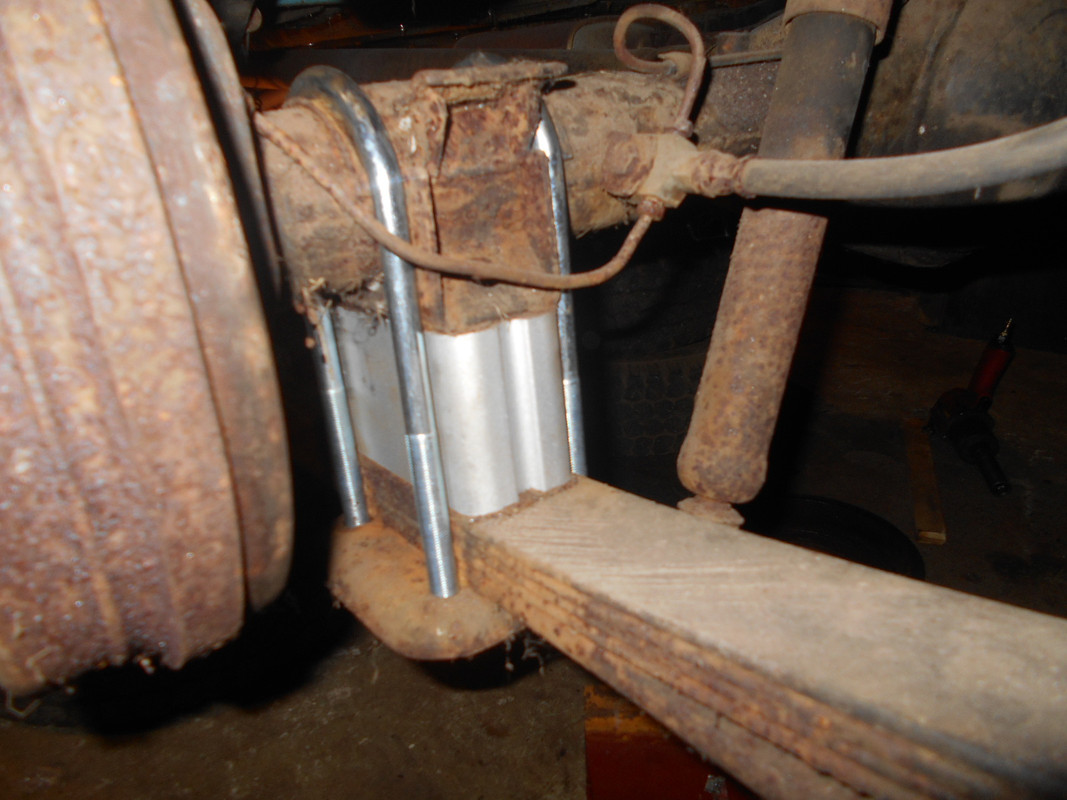
I pulled the rear drums off and seen moisture around the brake cylinders, so I ordered new ones, they are supposed to be in tomorrow, I also have new adjusters but I went thru all the effort to get the old ones working a couple months ago for what I thought was the new owner, well he bailed, so now I have a 320 kingcab.
I checked the clearance for these today, it might be too tight, I might have to have the intake manifold shaved at an eighth inch at an angle, top shaved an 1/8th, bottom not shaved at all, so that it tilts the carbs up an inch to clear the steering column.
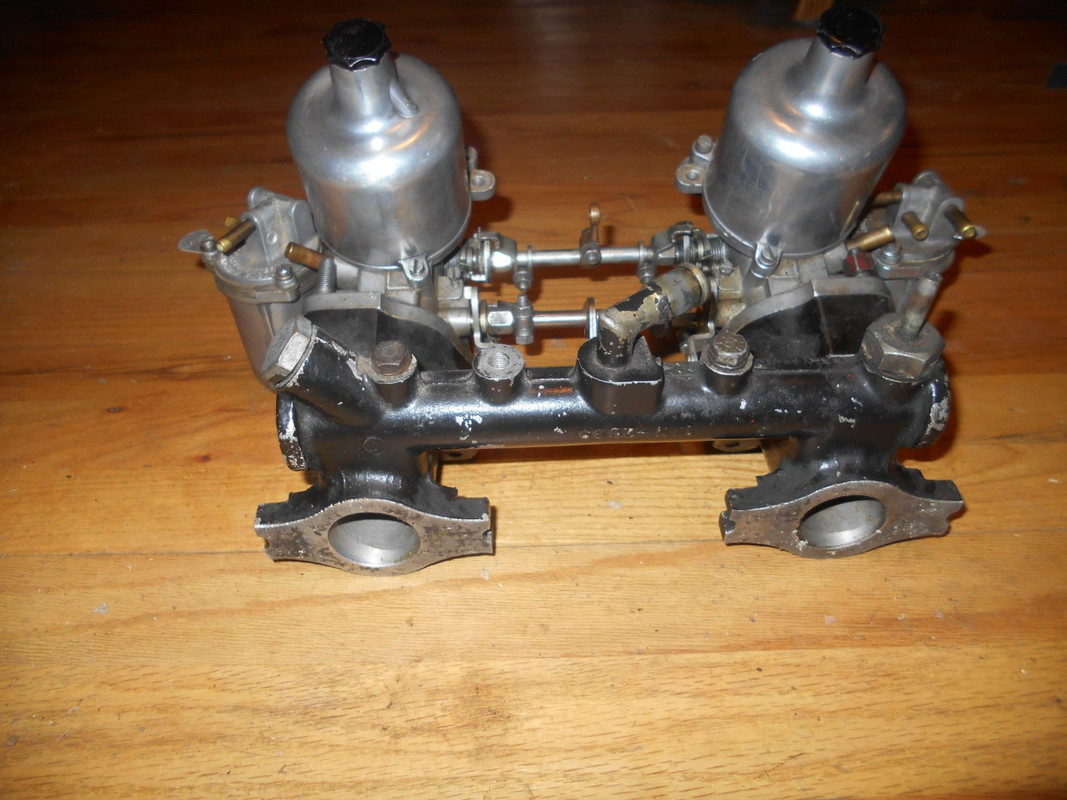
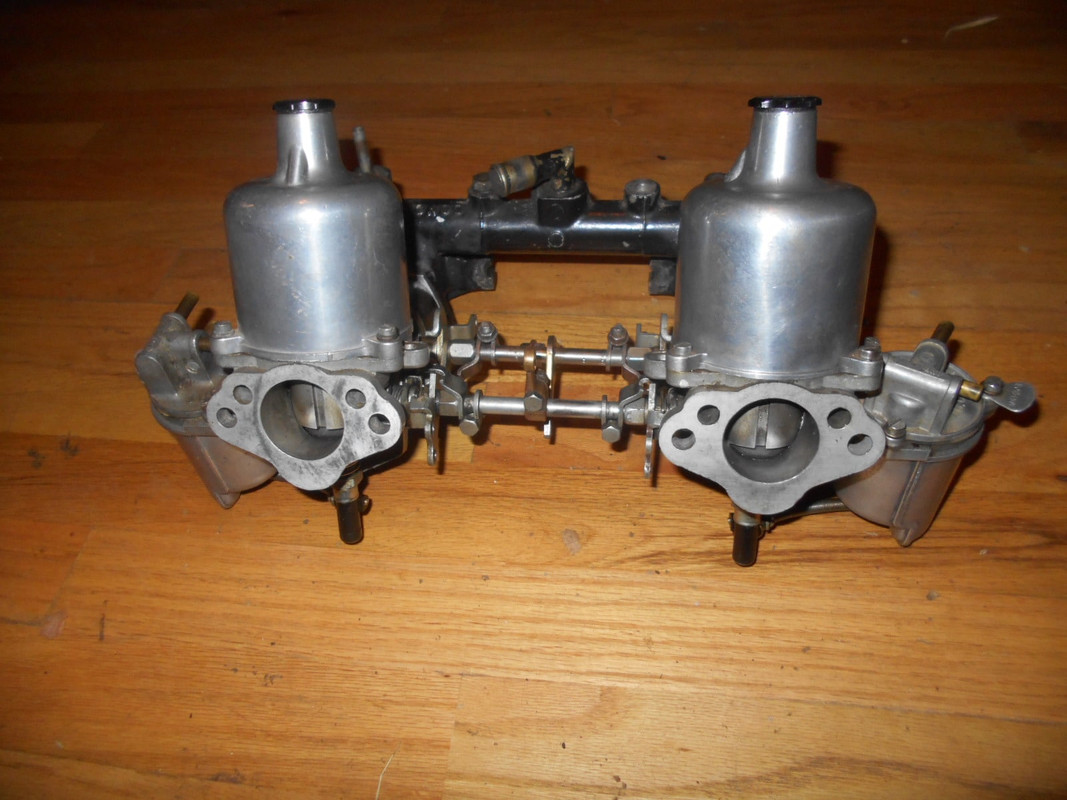
I am not here yet, but I wanted to see if it would clear the column, I am not sure it will.


I have brake lines coming for these disc brake calipers, but I looked at the stock soft brake line ends, they looked like the banjo bolt was the same size, so I tried the new banjo bolt in the old brake line end and it fit fine till the last eighth inch, so I counter sunk the end of the line so it fit properly, and attached the old lines to the new calipers, I will find out when I bleed the brakes if it worked, this way I don't have to remove the brake lines from the truck to replace the SAE fitting with a metric fitting so it will connect to the new soft brake line.
The stock 320 rims will not clear the calipers, they are hitting the rivets dead center and the piece of metal left of the rivet, they all hit, I can pound down the metal pieces with no issues, but the rivets I can only grind on, they barely hit right now, not sure until after I bleed the brakes, they might get better, worse, or stay the same after bleeding the brakes, you can barely see where they have hit, it looks like two silver spots in the photo.

I put 3 inch drop blocks in the rear.

I pulled the rear drums off and seen moisture around the brake cylinders, so I ordered new ones, they are supposed to be in tomorrow, I also have new adjusters but I went thru all the effort to get the old ones working a couple months ago for what I thought was the new owner, well he bailed, so now I have a 320 kingcab.
I checked the clearance for these today, it might be too tight, I might have to have the intake manifold shaved at an eighth inch at an angle, top shaved an 1/8th, bottom not shaved at all, so that it tilts the carbs up an inch to clear the steering column.


I am not here yet, but I wanted to see if it would clear the column, I am not sure it will.
“The difference between genius and stupidly is that genius has its limits” Albert Einstein
- DRIVEN
- Posts: 7699
- Joined: Thu Jun 27, 2013 7:05 pm
- Location: I've been everywhere
- Has thanked: 1210 times
- Been thanked: 1180 times
Re: 1963 Datsun 320 kingcab
Well, even though there was a gap in the posts, you clearly weren't messing around.
When the only tool you have is a hammer every problem starts to look like a hippy.
- wayno
- Posts: 5320
- Joined: Thu Jun 27, 2013 8:44 pm
- Location: Vancouver WA
- Has thanked: 432 times
- Been thanked: 1302 times
Re: 1963 Datsun 320 kingcab
I am having a hard time getting the brakes to work properly, they are spongy after pumping to get any pedal/braking, and I can't seem to fix it, this is the 3rd different master I have used now, this last one is brand new, I cannot get any decent flow out the rear bleeders and I did them first, it barely dribbles out if anything happens at all, and I have bench bled both of the dual type masters before installing them.
If I pump the brakes I can get it to stop but if I let off they go back to needing pumped again, if I adjust the pedal push rod in far enough the brakes seize after using them even once, but when I back it off(half turn) I have to pump them again, the second master I removed the residual valve for the front as I could not get the front to release no matter where the pedal rod was adjusted.
This truck has been burning out just to get it back in the garage, it has a shitload of power now, but I need brakes also, I just don't get it.
I have been thinking about connecting the front circuit to the rear and looping the rear back into its own reservoir till the backs are bled, but when I put the lines back where they are supposed to be I will have air in the lines again, I don't believe the fluid is moving fast enough to get the air out of the rear lines, I worked on this for several hours today.
I will go to the parts store and see if they have anything that can pull the fluid/air out of the lines thru the bleeders, I thought about pressurizing the reservoir to see if I could push the fluid thru using an old cap with a small hole drilled in it, but never heard of anyone doing that before, I have heard of vacuum bleeders though.
This is likely the longest I have ever spent on bleeding brakes without succeeding, it's very frustrating.
If I pump the brakes I can get it to stop but if I let off they go back to needing pumped again, if I adjust the pedal push rod in far enough the brakes seize after using them even once, but when I back it off(half turn) I have to pump them again, the second master I removed the residual valve for the front as I could not get the front to release no matter where the pedal rod was adjusted.
This truck has been burning out just to get it back in the garage, it has a shitload of power now, but I need brakes also, I just don't get it.
I have been thinking about connecting the front circuit to the rear and looping the rear back into its own reservoir till the backs are bled, but when I put the lines back where they are supposed to be I will have air in the lines again, I don't believe the fluid is moving fast enough to get the air out of the rear lines, I worked on this for several hours today.
I will go to the parts store and see if they have anything that can pull the fluid/air out of the lines thru the bleeders, I thought about pressurizing the reservoir to see if I could push the fluid thru using an old cap with a small hole drilled in it, but never heard of anyone doing that before, I have heard of vacuum bleeders though.
This is likely the longest I have ever spent on bleeding brakes without succeeding, it's very frustrating.
“The difference between genius and stupidly is that genius has its limits” Albert Einstein
- DRIVEN
- Posts: 7699
- Joined: Thu Jun 27, 2013 7:05 pm
- Location: I've been everywhere
- Has thanked: 1210 times
- Been thanked: 1180 times
Re: 1963 Datsun 320 kingcab
I would be suspicious of the rubber hoses, especially the one at the rearend. They can come apart internally and act as check valves causing all kinds of weird brake symptoms. They're only 55 years old, after all.
When the only tool you have is a hammer every problem starts to look like a hippy.
- wayno
- Posts: 5320
- Joined: Thu Jun 27, 2013 8:44 pm
- Location: Vancouver WA
- Has thanked: 432 times
- Been thanked: 1302 times
Re: 1963 Datsun 320 kingcab
I did reuse all the rubber hoses, I did have the fluid squirting back out of the fluid reservoir in the front circuit, I had to put the lid on it to keep the fluid in the reservoir, but the brakes were solid before, not spongy at all and the brakes worked fine.DRIVEN wrote:I would be suspicious of the rubber hoses, especially the one at the rearend. They can come apart internally and act as check valves causing all kinds of weird brake symptoms. They're only 55 years old, after all.
I did think about this also, I have new front hoses, but to use them I will have to remove the front hard lines to put new metric ends on the wheel connections, right now I am using the original front and rear hard lines with new ends to attach them to the brake master.
The other thing is that I get no pressure to the rear lines to bleed them and I did them first, when I bench bled both the dual circuit masters I got very little flow from the rear circuits, I thought that was weird on the first used master, that is why I used the brand new master the second try, but it bench bled the same way, very little flow thru the rear circuit, but the second brake master had a hurdle, the front lines already had fluid in them from the first dual master I had in it, so I still started with air in the front line, but got very little flow.
I am going to try a few things today, if none of them work, I will make a new front circuit with new hard lines and hoses, I have a metric block I can use to split the lines for the front, I believe I have a new SAE rubber line for the rear also.
“The difference between genius and stupidly is that genius has its limits” Albert Einstein
- wayno
- Posts: 5320
- Joined: Thu Jun 27, 2013 8:44 pm
- Location: Vancouver WA
- Has thanked: 432 times
- Been thanked: 1302 times
Re: 1963 Datsun 320 kingcab
I made new lines for the front so I could use the new front rubber hoses for the calipers, I also had to make a new line going to the rear, I worked 8 hours on this today, there is no air in any of the lines and nothing has changed.
The reason I had to make a new rear line was because I pressed so hard on the pedal it blew the line, but I guess that is good, would not have been happy if it had blew trying to stop.
My issue is that I can adjust the pedal rod to a very fine point, I can turn it in towards the brake master till I have pedal every time I push on the pedal, but the front rotors are clamped so tight I have to use a pry bar to turn them, the backs are loose, so then I turn the pedal rod back away from the master an eighth to almost a quarter turn and the rotors are easier to turn, but still dragging pretty bad, but the pedal goes to the floor, but a few pumps and I have pedal again, if I turn it away from the master another eighth/quarter turn it takes several pumps to get pedal, but the rotors can be turned by hand if I grip them tight.
Could new brake pads in the front do this, I just don't see it being the cause.
The front brakes are the issue, I can feel when I get to the rear circuit, it's like hitting a wall, but I can press harder and it gives to the floor.
After replacing the rear line I was able to bleed the rears pretty easy, so the rear line was likely almost plugged, but the fronts either drag really bad, or the pedal has to be pumped.
Any one have any ideas, I likely have over 20 hours into trying to get these brakes working properly, I have new calipers, new rotors, new brake master, all new front lines that I made from scratch, new line to the rear, it still has the old rear hose and the old lines going to the new rear brake cylinders, I don't see the rear hose being an issue or causing the front brakes to seize/drag badly.
The fronts are dragging bad enough that I believe they will eventually catch fire if they don't stop the truck dead from lack of power or enough weight in the back to keep it moving, I have never had an issue like this before.
Could I be using the wrong size master brake cylinder, both the dual circuit masters I have tried to use were 13/16ths, Mike put 15/16ths on the NL320 that he sold me, could this be my issue?
The reason I had to make a new rear line was because I pressed so hard on the pedal it blew the line, but I guess that is good, would not have been happy if it had blew trying to stop.
My issue is that I can adjust the pedal rod to a very fine point, I can turn it in towards the brake master till I have pedal every time I push on the pedal, but the front rotors are clamped so tight I have to use a pry bar to turn them, the backs are loose, so then I turn the pedal rod back away from the master an eighth to almost a quarter turn and the rotors are easier to turn, but still dragging pretty bad, but the pedal goes to the floor, but a few pumps and I have pedal again, if I turn it away from the master another eighth/quarter turn it takes several pumps to get pedal, but the rotors can be turned by hand if I grip them tight.
Could new brake pads in the front do this, I just don't see it being the cause.
The front brakes are the issue, I can feel when I get to the rear circuit, it's like hitting a wall, but I can press harder and it gives to the floor.
After replacing the rear line I was able to bleed the rears pretty easy, so the rear line was likely almost plugged, but the fronts either drag really bad, or the pedal has to be pumped.
Any one have any ideas, I likely have over 20 hours into trying to get these brakes working properly, I have new calipers, new rotors, new brake master, all new front lines that I made from scratch, new line to the rear, it still has the old rear hose and the old lines going to the new rear brake cylinders, I don't see the rear hose being an issue or causing the front brakes to seize/drag badly.
The fronts are dragging bad enough that I believe they will eventually catch fire if they don't stop the truck dead from lack of power or enough weight in the back to keep it moving, I have never had an issue like this before.
Could I be using the wrong size master brake cylinder, both the dual circuit masters I have tried to use were 13/16ths, Mike put 15/16ths on the NL320 that he sold me, could this be my issue?
“The difference between genius and stupidly is that genius has its limits” Albert Einstein
- Laecaon
- Site Admin
- Posts: 4793
- Joined: Wed Jun 26, 2013 7:21 pm
- Cars: '71 510 Wagon, 02 BMW 325i Wagon
- Location: PDX, West side.
- Has thanked: 288 times
- Been thanked: 329 times
Re: 1963 Datsun 320 kingcab
To small a MC will make it not move enough fluid to fill the piston of the caliper, seems like 510 guys often have this problem going to ZX front brakes.
Are you sure you have the front and rear circuits hooked up to the MC correctly? It would seem I have seen the ports on the MC backwards on some of them.
Are you sure you have the front and rear circuits hooked up to the MC correctly? It would seem I have seen the ports on the MC backwards on some of them.
- wayno
- Posts: 5320
- Joined: Thu Jun 27, 2013 8:44 pm
- Location: Vancouver WA
- Has thanked: 432 times
- Been thanked: 1302 times
Re: 1963 Datsun 320 kingcab
I have the circuits piped correctly, I have not dealt with this so many hours not to notice that kind of screw up.
I emailed Mike about this as he put a 15/16ths brake master in the NL320 while I am trying to use 13/16ths, I will wait to see what he has to say.
I will likely go get a 15/16ths master tomorrow as it works fine on the NL320.
I have never had this issue and I have been using this same size master on everything I have built, but this is a 320, I don't know if there is a difference in the pedal throw between a 320 and a 520/521.
Thankyou for the reply.
I emailed Mike about this as he put a 15/16ths brake master in the NL320 while I am trying to use 13/16ths, I will wait to see what he has to say.
I will likely go get a 15/16ths master tomorrow as it works fine on the NL320.
I have never had this issue and I have been using this same size master on everything I have built, but this is a 320, I don't know if there is a difference in the pedal throw between a 320 and a 520/521.
Thankyou for the reply.
“The difference between genius and stupidly is that genius has its limits” Albert Einstein
Re: 1963 Datsun 320 kingcab
I'm going to add some other links and refs to this at the end. They cover a ton of the adjustment and bleeding issues. I've already spent an hour rounding this up, so I'm not going to take the time to write it all out here. Wayno....I'm going to write this as if it's addressing anyone/everyone, so I may be covering stuff you've already thought of or done, but the info will be here for the next guy.
Sounds like the first issue is the m/c push rod. There's really only one proper way to adjust it. When the pedal is up all the way....should be a spring pulling the pedal up so that it doesn't bounce around when not used. The push rod should be just a hair loose. If it can't wiggle at all, then it's probably too tight. You want it loose enough that you can move the clevis pin in it's hole, but not so loose that the push rod rattles or sags in the pocket on the m/c. If the push rod is pushing the piston in on the m/c when the pedal is up, there's a chance that's it's not letting the fluid return into the reservoir. Sounds like you have the push rod holding the piston right at the edge of the return hole. Tightening it a bit causes it to block the return hole....loosening it opens the hole. The pumping required when the hole is open is another matter. The push rod and m/c don't don't affect pedal travel.....at least not in an adjustable way. As mentioned by others....a smaller bore moves less fluid so the pedal has to travel further to move the same volume as a larger bore m/c. Having the push rod in too tight, hoping to "preload" the calipers or cylinders is counter to what's needed. If you have the piston pushed in a 1/4", hoping that it's holding the brakes in closer so they require less travel......you're actually using up a 1/4" of travel you need...it's already used up that volume. You want the piston toward the push rod as much as possible.
If the pedals needs to be pumped to get a firm pedal, then it's most likely the rear brakes that need adjusting....assuming they're drums. If the e-brake works.....engage it fully. Pump the pedal....first push will probably go to the floor....second should come up firm. Take your foot off the pedal and let it sit for a second or two. Press on the pedal again....it should come up firm and feel like you'd expect your brakes to feel on the first pump. If this is the case, then your shoes are not adjusted well enough in the rear. They're requiring too much travel distance to engage.
When adjusting the rear....the manual says to adjust until you can't turn the drum, then back off "X" number of clicks. I don't typically find their number to be very accurate. Back in the days when these trucks were new, shoes were "fitted" to the drums. The were put on a machine and sanded to match the exact diameter of the drum. When they engaged in the drum, they contacted the entire surface of the shoe....pretty much at the same time. These days....they just slap some material on the shoe frame and call it good. That results in a lot of fitment issues. High spots cause the shoe surface to rub only in some places. It will feel like it's dragging really hard or seem locked up when you turn it be hand....but the reality is that there's hardly any surface touching. Certainly not enough to stop the vehicle. If you're turning the drum without having the rim/tire on, it's even worse. I always mount the rim and tire...one, it makes sure that the drum is torqued evenly and less likely to be warped while you're making adjustments since it's how it's going to be when on the road in use......two...it gives you a ton more leverage to turn the drum so you can better gauge how much rubbing you actually have.
I adjust until I get rubbing......then I press the brake pedal to engage the brakes. Pump if you have to at this point, but you want the brakes to engage firmly. Each time they're adjusted, they change position slightly. Engaging the brakes causes them to recenter. Adjust again until you get rubbing. You may have to repeat a few times. If you haven't had the drums resurfaced, you'll most likely get intermittent rubbing. If they're nice and true, then it will be constant or at least close. You'll notice from the sound of the rubbing that's it's only a small portion of the shoe that's rubbing. If even half of the shoe was making contact at the same time, you'd be hard pressed to turn the rim.
For the break in period of the shoes, it's going to be a trade off between some rubbing and good pedal travel(no pumping). After they've been "bedded" to the drums.....which is basically the shoes being worn to match the drum surface....the pedal will have to travel more, but it will feel a lot firmer when it engages. You'll need to go back and readjust them again like before. They should be good to go for some time now. I tend to adjust them for a fair amount of rubbing initially, knowing that they're going to wear the high spots down pretty quickly. It can cause hot spots and other issues, so there's a fine line. It's better to have light rubbing and then readjust in a few days.
Couple of things before I put in the links/info....
A smaller bore m/c will travel more, but require a bit less leg effort. You just don't want it too small. I tend to use the 15/16" bores, but I'm short. My leg is not at a massively acute angle....basically, I get better leverage since my leg is more straight. Taller guys will probably prefer the slightly smaller bores. I've only ever used the 15/16", so I have no clue just how much difference there is in the "feel".
If the brakes are spongy....there's typically air in the lines. If you're getting a firm pedal and pushing hard makes it seem like it's a bit spongy...like there's some give....that's because there is. The rubber lines will balloon a bit adding to that feeling. New pads/shoes are not rock hard until they've been properly bedded. You're dealing with a hydraulic system that creates a lot of pressure.....some stuff can "give" a bit. Air in the lines is a much lighter feeling.
If you have to pump, but then get a firm pedal.....it's the system requiring more fluid than the m/c can put out in one stroke. Typically, it's drum adjustment. If you have 4 wheel discs.....then it can be that the m/c is undersized.....but unlikely. Caliper pistons don't move that much....so they don't take a lot of fluid.
Biasing on the brakes is a whole other thing....not one I'm even remotely able to explain.......but it can all be figured out with math. Anyway.....I gotta get busy!
Anyway.....I gotta get busy!
hmm...this is long enough. I'll post this and then post the other info.
Sounds like the first issue is the m/c push rod. There's really only one proper way to adjust it. When the pedal is up all the way....should be a spring pulling the pedal up so that it doesn't bounce around when not used. The push rod should be just a hair loose. If it can't wiggle at all, then it's probably too tight. You want it loose enough that you can move the clevis pin in it's hole, but not so loose that the push rod rattles or sags in the pocket on the m/c. If the push rod is pushing the piston in on the m/c when the pedal is up, there's a chance that's it's not letting the fluid return into the reservoir. Sounds like you have the push rod holding the piston right at the edge of the return hole. Tightening it a bit causes it to block the return hole....loosening it opens the hole. The pumping required when the hole is open is another matter. The push rod and m/c don't don't affect pedal travel.....at least not in an adjustable way. As mentioned by others....a smaller bore moves less fluid so the pedal has to travel further to move the same volume as a larger bore m/c. Having the push rod in too tight, hoping to "preload" the calipers or cylinders is counter to what's needed. If you have the piston pushed in a 1/4", hoping that it's holding the brakes in closer so they require less travel......you're actually using up a 1/4" of travel you need...it's already used up that volume. You want the piston toward the push rod as much as possible.
If the pedals needs to be pumped to get a firm pedal, then it's most likely the rear brakes that need adjusting....assuming they're drums. If the e-brake works.....engage it fully. Pump the pedal....first push will probably go to the floor....second should come up firm. Take your foot off the pedal and let it sit for a second or two. Press on the pedal again....it should come up firm and feel like you'd expect your brakes to feel on the first pump. If this is the case, then your shoes are not adjusted well enough in the rear. They're requiring too much travel distance to engage.
When adjusting the rear....the manual says to adjust until you can't turn the drum, then back off "X" number of clicks. I don't typically find their number to be very accurate. Back in the days when these trucks were new, shoes were "fitted" to the drums. The were put on a machine and sanded to match the exact diameter of the drum. When they engaged in the drum, they contacted the entire surface of the shoe....pretty much at the same time. These days....they just slap some material on the shoe frame and call it good. That results in a lot of fitment issues. High spots cause the shoe surface to rub only in some places. It will feel like it's dragging really hard or seem locked up when you turn it be hand....but the reality is that there's hardly any surface touching. Certainly not enough to stop the vehicle. If you're turning the drum without having the rim/tire on, it's even worse. I always mount the rim and tire...one, it makes sure that the drum is torqued evenly and less likely to be warped while you're making adjustments since it's how it's going to be when on the road in use......two...it gives you a ton more leverage to turn the drum so you can better gauge how much rubbing you actually have.
I adjust until I get rubbing......then I press the brake pedal to engage the brakes. Pump if you have to at this point, but you want the brakes to engage firmly. Each time they're adjusted, they change position slightly. Engaging the brakes causes them to recenter. Adjust again until you get rubbing. You may have to repeat a few times. If you haven't had the drums resurfaced, you'll most likely get intermittent rubbing. If they're nice and true, then it will be constant or at least close. You'll notice from the sound of the rubbing that's it's only a small portion of the shoe that's rubbing. If even half of the shoe was making contact at the same time, you'd be hard pressed to turn the rim.
For the break in period of the shoes, it's going to be a trade off between some rubbing and good pedal travel(no pumping). After they've been "bedded" to the drums.....which is basically the shoes being worn to match the drum surface....the pedal will have to travel more, but it will feel a lot firmer when it engages. You'll need to go back and readjust them again like before. They should be good to go for some time now. I tend to adjust them for a fair amount of rubbing initially, knowing that they're going to wear the high spots down pretty quickly. It can cause hot spots and other issues, so there's a fine line. It's better to have light rubbing and then readjust in a few days.
Couple of things before I put in the links/info....
A smaller bore m/c will travel more, but require a bit less leg effort. You just don't want it too small. I tend to use the 15/16" bores, but I'm short. My leg is not at a massively acute angle....basically, I get better leverage since my leg is more straight. Taller guys will probably prefer the slightly smaller bores. I've only ever used the 15/16", so I have no clue just how much difference there is in the "feel".
If the brakes are spongy....there's typically air in the lines. If you're getting a firm pedal and pushing hard makes it seem like it's a bit spongy...like there's some give....that's because there is. The rubber lines will balloon a bit adding to that feeling. New pads/shoes are not rock hard until they've been properly bedded. You're dealing with a hydraulic system that creates a lot of pressure.....some stuff can "give" a bit. Air in the lines is a much lighter feeling.
If you have to pump, but then get a firm pedal.....it's the system requiring more fluid than the m/c can put out in one stroke. Typically, it's drum adjustment. If you have 4 wheel discs.....then it can be that the m/c is undersized.....but unlikely. Caliper pistons don't move that much....so they don't take a lot of fluid.
Biasing on the brakes is a whole other thing....not one I'm even remotely able to explain.......but it can all be figured out with math.
hmm...this is long enough. I'll post this and then post the other info.
Don't have to be too bright to be me!!
Sadly, I prove it daily!
http://www.bluehandsinc.com/
http://www.youtube.com/user/bluehandsvideo
Sadly, I prove it daily!
http://www.bluehandsinc.com/
http://www.youtube.com/user/bluehandsvideo
Re: 1963 Datsun 320 kingcab
http://community.ratsun.net/topic/33313 ... ntry506002
As I understand it, there is actually a bit of difference between bench bleeding and bleeding the m/c with the pedal. When you bench bleed, the m/c is level(which it's not in the vehicle) and you bottom out the pistons in the m/c. The pedal will not bottom them out. You can take the push rod out and use a long screwdriver to do it in the vehicle, but I'm not sure if that works with a booster and the m/c is not level so there's a small chance it can trap air in the cylinder. With that said, you should still be getting some kind of pressure. When you said you had it adjusted so that it was engaged when mounted....there needs to be a tiny amount of play or a tiny bit of tension. You don't want it pushing the pistons in at all when the pedal is disengaged. If you're bleeding it yourself with a hose and jar, the bleeder valve or line nut can't be too loose or it will suck air back in around the threads.
On that m/c, the rear circuit is toward the front of the truck. It sounds like the back(front circuit) piston is moving just fine, but I wonder if the front(back circuit) piston is moving. There's a screw on the bottom that has a pin that sticks up into the m/c bore to keep the piston from moving too far toward the pedal and interfering with the front circuit. I wonder if that's in the correct place on the piston or if it's stopping the piston from moving forward when you press on the pedal.
http://community.ratsun.net/topic/47538 ... frontrear/
With drums, the springs collapse the wheel cylinder pushing the fluid back to the m/c and reservoir. Since there's no springs in a caliper, they don't push the fluid back to the m/c. The piston in the m/c will pull fluid a bit as the pedal is let off, but it doesn't typically create enough pull or fluid movement to pull the caliper back. I'd say set the e-brake, but I'm guessing you don't have cables hooked up....I've only seen one person that's bothered to hook them up with a rear disc conversion. You might try to find a way to activate the e-brake levers on the calipers, then re-bleed the rears. That way, there will be enough fluid in there and what ever is "pulling" the piston back won't be able to.
If your push rod was too short, you'd have a lot of pedal travel before it engaged the m/c piston. The spring on the pedal under the dash will hold the pedal up....you should only have about an 1/8" - 1/4" of pedal movement before the pushrod is fully seated in the m/c and starts pushing the piston. BUT!!!.... you must have at least a small amount of movement to make sure that the m/c piston is coming back all the way. If it does not come back all the way, it won't let the fluid back into the reservoir or let move fluid into the m/c bore.
I'm not familiar at all with the load sensing proportioning valve on the 620's.....since you have an adjustable in the rear circuit, I would eliminate the load valve. It may be the culprit.
Another possibility......the front/rear circuit positions changed around a bit from year to year, model to model on the m/c's. There should be an F and an R on the m/c....double check that your front brakes are connected to the F and the rears to the R.
I'm going to change up what Mike said on the bench bleeding. The point of bench bleeding the m/c is to get all the air out of the m/c.....all agree on that. But, the biggest reason they're bled on the "bench" is because they are not typically level when mounted in the car and the pedal assembly will not push the pistons completely in. I do the bench bleed on the car. I jack up the rear end just a bit to get the m/c level(on some cars, the m/c is at a severe angle, but not so on datsuns) and I take out the pushrod under the dash. It will take a second person to do it my way, which is another advantage to Mike's way. There's bleeders on the m/c, so you can have all your lines hooked up. Have a helper crack both bleeder valves open, then you can take a long screwdriver or dowel and push the m/c piston in until it completely bottoms out.....hold it there and have the helper close both valves. Let up on the piston. Repeat a couple of times, but there's no need to do it a dozen times. I go one step further and I also do it at the brake line connections under the m/c. Then I know I've got fluid coming into the lines and the air is removed. Just make sure the piston is not let up at all while the valves or lines are open. You can put the pushrod back in to bleed the rest of the system.
oh....and Mike's right about the residual valve, but they're really only ever used when the m/c is located below the calipers or wheel cylinders.....as in really old cars where the m/c is under the floor board, attached to the frame. They're used to keep the fluid from being drained back into the m/c. Using a 10lb on a caliper will cause it to drag quite a bit.
http://community.ratsun.net/topic/6033- ... entry76612
http://community.ratsun.net/topic/21123-521-brakes/
As I understand it, there is actually a bit of difference between bench bleeding and bleeding the m/c with the pedal. When you bench bleed, the m/c is level(which it's not in the vehicle) and you bottom out the pistons in the m/c. The pedal will not bottom them out. You can take the push rod out and use a long screwdriver to do it in the vehicle, but I'm not sure if that works with a booster and the m/c is not level so there's a small chance it can trap air in the cylinder. With that said, you should still be getting some kind of pressure. When you said you had it adjusted so that it was engaged when mounted....there needs to be a tiny amount of play or a tiny bit of tension. You don't want it pushing the pistons in at all when the pedal is disengaged. If you're bleeding it yourself with a hose and jar, the bleeder valve or line nut can't be too loose or it will suck air back in around the threads.
On that m/c, the rear circuit is toward the front of the truck. It sounds like the back(front circuit) piston is moving just fine, but I wonder if the front(back circuit) piston is moving. There's a screw on the bottom that has a pin that sticks up into the m/c bore to keep the piston from moving too far toward the pedal and interfering with the front circuit. I wonder if that's in the correct place on the piston or if it's stopping the piston from moving forward when you press on the pedal.
http://community.ratsun.net/topic/47538 ... frontrear/
With drums, the springs collapse the wheel cylinder pushing the fluid back to the m/c and reservoir. Since there's no springs in a caliper, they don't push the fluid back to the m/c. The piston in the m/c will pull fluid a bit as the pedal is let off, but it doesn't typically create enough pull or fluid movement to pull the caliper back. I'd say set the e-brake, but I'm guessing you don't have cables hooked up....I've only seen one person that's bothered to hook them up with a rear disc conversion. You might try to find a way to activate the e-brake levers on the calipers, then re-bleed the rears. That way, there will be enough fluid in there and what ever is "pulling" the piston back won't be able to.
If your push rod was too short, you'd have a lot of pedal travel before it engaged the m/c piston. The spring on the pedal under the dash will hold the pedal up....you should only have about an 1/8" - 1/4" of pedal movement before the pushrod is fully seated in the m/c and starts pushing the piston. BUT!!!.... you must have at least a small amount of movement to make sure that the m/c piston is coming back all the way. If it does not come back all the way, it won't let the fluid back into the reservoir or let move fluid into the m/c bore.
I'm not familiar at all with the load sensing proportioning valve on the 620's.....since you have an adjustable in the rear circuit, I would eliminate the load valve. It may be the culprit.
Another possibility......the front/rear circuit positions changed around a bit from year to year, model to model on the m/c's. There should be an F and an R on the m/c....double check that your front brakes are connected to the F and the rears to the R.
I'm going to change up what Mike said on the bench bleeding. The point of bench bleeding the m/c is to get all the air out of the m/c.....all agree on that. But, the biggest reason they're bled on the "bench" is because they are not typically level when mounted in the car and the pedal assembly will not push the pistons completely in. I do the bench bleed on the car. I jack up the rear end just a bit to get the m/c level(on some cars, the m/c is at a severe angle, but not so on datsuns) and I take out the pushrod under the dash. It will take a second person to do it my way, which is another advantage to Mike's way. There's bleeders on the m/c, so you can have all your lines hooked up. Have a helper crack both bleeder valves open, then you can take a long screwdriver or dowel and push the m/c piston in until it completely bottoms out.....hold it there and have the helper close both valves. Let up on the piston. Repeat a couple of times, but there's no need to do it a dozen times. I go one step further and I also do it at the brake line connections under the m/c. Then I know I've got fluid coming into the lines and the air is removed. Just make sure the piston is not let up at all while the valves or lines are open. You can put the pushrod back in to bleed the rest of the system.
oh....and Mike's right about the residual valve, but they're really only ever used when the m/c is located below the calipers or wheel cylinders.....as in really old cars where the m/c is under the floor board, attached to the frame. They're used to keep the fluid from being drained back into the m/c. Using a 10lb on a caliper will cause it to drag quite a bit.
http://community.ratsun.net/topic/6033- ... entry76612
http://community.ratsun.net/topic/21123-521-brakes/
Don't have to be too bright to be me!!
Sadly, I prove it daily!
http://www.bluehandsinc.com/
http://www.youtube.com/user/bluehandsvideo
Sadly, I prove it daily!
http://www.bluehandsinc.com/
http://www.youtube.com/user/bluehandsvideo
- wayno
- Posts: 5320
- Joined: Thu Jun 27, 2013 8:44 pm
- Location: Vancouver WA
- Has thanked: 432 times
- Been thanked: 1302 times
Re: 1963 Datsun 320 kingcab
Thankyou for the reply Mike 
Yes I have the pedal rod adjusted so that the return hole is cut off just to get pedal without having to pump the brakes to get pedal, every time I back it off I loose the pedal, and that only takes a quarter turn of the pedal rod to happen.
At one point I removed the rear drums and loosened the rear adjusters, I cannot remember why now, I will go back out and re-adjust them tighter again, I have tried so many things to get this to work that I have forgotten or didn't post what I did, so then everyone reading this thread doesn't have the whole story, I have a lot of time into this brake thing so far, I have used 3 methods too bleed these brakes, the ones I recall are,
Pump the brakes and hold, open the bleeder screw till bled starting at the back, close the bleeder screw and let off the pedal, check reservoir, repeat,
Another is connect a clear hose to bleeder screw, put the other end in a cup of brake fluid, open bleeder screw, get in truck and pump the brakes while watching clear hose, pump until all air is out of clear hose and no more air is coming out, close bleeder screw, repeat on all 3 other corners starting at the back.
I even got tired of these two upper methods when doing the back brakes, so I made sure the pedal rod was loose, found another cap for the rear circuit reservoir as it is a new unit, drilled a small hole in the center, put it on the reservoir, went to back drums and put clear hose on bleeder screw and then opened it, then using my air compressor I forced the fluid thru the lines using that small hole in the cap, this actually worked quite well as long as the bleeder screw was open far enough, I could see the air coming out.
As I said before, I pressed so hard on the brake pedal once that I blew the rear brake line up near the front, after I replaced that line the rear brakes bled much easier, so I am assuming that the rear line was at least partially blocked, but I have not tightened/loosened/readjusted the rear drums in a couple days now, yes I have been dealing with this for days now.
I will go out and loosen the pedal rod again and put it where it is supposed to be again, I will then adjust the rear drums again till they drag the way my career mechanic dad taught me(spin the tire by hand till it just doesn't get around one complete turn from the drag), then I will get in the truck and see what the pedal does, if that doesn't fix it then the only thing I can think of doing is to replace the master again, it's kinda a hassle as I have to oblong the mount holes so that it fits on the mount studs, then I cannot return it if it is a bad unit.
Yes I have the pedal rod adjusted so that the return hole is cut off just to get pedal without having to pump the brakes to get pedal, every time I back it off I loose the pedal, and that only takes a quarter turn of the pedal rod to happen.
At one point I removed the rear drums and loosened the rear adjusters, I cannot remember why now, I will go back out and re-adjust them tighter again, I have tried so many things to get this to work that I have forgotten or didn't post what I did, so then everyone reading this thread doesn't have the whole story, I have a lot of time into this brake thing so far, I have used 3 methods too bleed these brakes, the ones I recall are,
Pump the brakes and hold, open the bleeder screw till bled starting at the back, close the bleeder screw and let off the pedal, check reservoir, repeat,
Another is connect a clear hose to bleeder screw, put the other end in a cup of brake fluid, open bleeder screw, get in truck and pump the brakes while watching clear hose, pump until all air is out of clear hose and no more air is coming out, close bleeder screw, repeat on all 3 other corners starting at the back.
I even got tired of these two upper methods when doing the back brakes, so I made sure the pedal rod was loose, found another cap for the rear circuit reservoir as it is a new unit, drilled a small hole in the center, put it on the reservoir, went to back drums and put clear hose on bleeder screw and then opened it, then using my air compressor I forced the fluid thru the lines using that small hole in the cap, this actually worked quite well as long as the bleeder screw was open far enough, I could see the air coming out.
As I said before, I pressed so hard on the brake pedal once that I blew the rear brake line up near the front, after I replaced that line the rear brakes bled much easier, so I am assuming that the rear line was at least partially blocked, but I have not tightened/loosened/readjusted the rear drums in a couple days now, yes I have been dealing with this for days now.
I will go out and loosen the pedal rod again and put it where it is supposed to be again, I will then adjust the rear drums again till they drag the way my career mechanic dad taught me(spin the tire by hand till it just doesn't get around one complete turn from the drag), then I will get in the truck and see what the pedal does, if that doesn't fix it then the only thing I can think of doing is to replace the master again, it's kinda a hassle as I have to oblong the mount holes so that it fits on the mount studs, then I cannot return it if it is a bad unit.
“The difference between genius and stupidly is that genius has its limits” Albert Einstein
- wayno
- Posts: 5320
- Joined: Thu Jun 27, 2013 8:44 pm
- Location: Vancouver WA
- Has thanked: 432 times
- Been thanked: 1302 times
Re: 1963 Datsun 320 kingcab
Nothing has changed, I adjusted the rear brakes again which they were within a few clicks anyway(not even a turn of the star wheel), I bled each corner once and got no air after that.
With the pedal rod adjusted properly it takes 5/6 pumps to get any pedal, if I let off even one second it bottoms out for around 3 pumps to get pedal, if I wait 5 seconds I am back to 5/6 pumps to get any pedal.
If I had not had the same issue with the other master I would think I had busted this one, I suppose I can try the other one again to see if anything has changed(could I ruin two different types of them the same way), I am getting real good at bleeding the brakes, I don't even make a mess on the floor anymore.
I just checked and my 1969 Datsun 521 kingcab has a 13/16ths inch bore master and I don't have any issues with it, it has a total of around 5 inches pedal throw to the floor and I only use the top 2 inches, this 320 has over 6 inches of pedal throw and I use 5 inches of it before I hit a wall that has been there since I bled the rear brakes, I have felt this wall before in the 1969 Datsun kingcab when bleeding the brakes before, but the wall wasn't there when I started the bleeding of the brakes.
With the pedal rod adjusted properly it takes 5/6 pumps to get any pedal, if I let off even one second it bottoms out for around 3 pumps to get pedal, if I wait 5 seconds I am back to 5/6 pumps to get any pedal.
If I had not had the same issue with the other master I would think I had busted this one, I suppose I can try the other one again to see if anything has changed(could I ruin two different types of them the same way), I am getting real good at bleeding the brakes, I don't even make a mess on the floor anymore.
I just checked and my 1969 Datsun 521 kingcab has a 13/16ths inch bore master and I don't have any issues with it, it has a total of around 5 inches pedal throw to the floor and I only use the top 2 inches, this 320 has over 6 inches of pedal throw and I use 5 inches of it before I hit a wall that has been there since I bled the rear brakes, I have felt this wall before in the 1969 Datsun kingcab when bleeding the brakes before, but the wall wasn't there when I started the bleeding of the brakes.
“The difference between genius and stupidly is that genius has its limits” Albert Einstein
- wayno
- Posts: 5320
- Joined: Thu Jun 27, 2013 8:44 pm
- Location: Vancouver WA
- Has thanked: 432 times
- Been thanked: 1302 times
Re: 1963 Datsun 320 kingcab
Yes they have built in residual valves although it seems like this masters valves are not working too well.Laecaon wrote:These don't have load valves like the later trucks do they?
I don't think it is the issue though, I am going to try the other master again and if that don't work I will buy another one like what is in the NL320.
“The difference between genius and stupidly is that genius has its limits” Albert Einstein
- wayno
- Posts: 5320
- Joined: Thu Jun 27, 2013 8:44 pm
- Location: Vancouver WA
- Has thanked: 432 times
- Been thanked: 1302 times
Re: 1963 Datsun 320 kingcab
OK, I have just about changed everything in the truck brake wise now, I will start at the front wheels, new calipers, rotors, pads, and hoses for a 1985 Nissan 720 with Mikes disc brake brackets, newer metal hard lines off a 720 in the front, I used a 720 Y block in the center of the firewall to pipe to each front wheel hose as I had to change everything to metric, I tried a 720 brake master first, then I tried a brand new 1979 Datsun 620 dual master second, both are 13/16ths bore, which is the same as what I have in my 1969 Datsun kingcab and it also has 1985 Nissan 720 brakes, so I have the same everything and that one has properly functioning brakes, and this one don't, I have since put the 720 brake master back in, and I pulled the brand new master apart to see if anything was broken, it looked fine to me.
Now the rear brakes, I have new wheel brake cylinders, the lines on the axle are original to the truck, I put a new hose on today going from the rearend to the frame, I have 720 brake line going from the new hose to the master brake cylinders, everything has been changed except the brake lines on the axle, but I don't think the rear circuit is the issue, I believe something is going on in the front circuit.
Out of all the things I have done, only bleeding the rear brakes has improved.
I got my flashlight out and checked the front pads, they are not backing away from the rotors, I also checked to make sure the piston wasn't backing off but leaving the pads looking proper, the pistons are not backing off.
As I said, I have the same thing in the 521 kingcab, the only difference between that truck and this truck is that the kingcab has power brakes, and this one doesn't, I have never put a dual master on anything without a brake booster, this is the first time I have ever done it this way, am I missing something, should the bore be larger bore master brake cylinder without a booster?
The only thing I can think of is I have two bad masters, or there is something wrong with the calipers unless I am missing something with no booster involved.
Does anyone have a clue what could be wrong, as I am lost now, I took it down the block and back thinking maybe it had brakes, it just didn't feel like it to me, well I have no brakes unless I pump the brake pedal 4/5/6 times.
______________________________________________________________________________________________________________________________
EDIT
Well it had to be something, as air had to be in the lines somewhere, so after getting home and going over to the neighbors for a little visiting I came back home and wrote the reply above, and lost I was, I made the stupidest brake mistake in my life, and I don't recall if anyone asked if the calipers were on right side up, I went out to the truck to look look every piece over from the beginning, and it was the first thing I looked at, the calipers were on the wrong sides and the bleeder screws were on the bottom, and I never took a photo of the backs as I am sure someone would have figured it out, I can tell you one thing right now, I will never make that mistake again in my life, I have close to 30 hours into this trying to figure out the problem.

Now the rear brakes, I have new wheel brake cylinders, the lines on the axle are original to the truck, I put a new hose on today going from the rearend to the frame, I have 720 brake line going from the new hose to the master brake cylinders, everything has been changed except the brake lines on the axle, but I don't think the rear circuit is the issue, I believe something is going on in the front circuit.
Out of all the things I have done, only bleeding the rear brakes has improved.
I got my flashlight out and checked the front pads, they are not backing away from the rotors, I also checked to make sure the piston wasn't backing off but leaving the pads looking proper, the pistons are not backing off.
As I said, I have the same thing in the 521 kingcab, the only difference between that truck and this truck is that the kingcab has power brakes, and this one doesn't, I have never put a dual master on anything without a brake booster, this is the first time I have ever done it this way, am I missing something, should the bore be larger bore master brake cylinder without a booster?
The only thing I can think of is I have two bad masters, or there is something wrong with the calipers unless I am missing something with no booster involved.
Does anyone have a clue what could be wrong, as I am lost now, I took it down the block and back thinking maybe it had brakes, it just didn't feel like it to me, well I have no brakes unless I pump the brake pedal 4/5/6 times.
______________________________________________________________________________________________________________________________
EDIT
Well it had to be something, as air had to be in the lines somewhere, so after getting home and going over to the neighbors for a little visiting I came back home and wrote the reply above, and lost I was, I made the stupidest brake mistake in my life, and I don't recall if anyone asked if the calipers were on right side up, I went out to the truck to look look every piece over from the beginning, and it was the first thing I looked at, the calipers were on the wrong sides and the bleeder screws were on the bottom, and I never took a photo of the backs as I am sure someone would have figured it out, I can tell you one thing right now, I will never make that mistake again in my life, I have close to 30 hours into this trying to figure out the problem.

“The difference between genius and stupidly is that genius has its limits” Albert Einstein